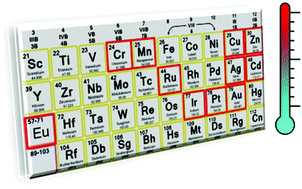Thermo-responsive light-emitting metal complexes and related materials
Abstract
Thermo-responsive light-emitting materials have wide potential applications in temperature sensing, bioimaging, optoelectronic devices and information security, due to their intriguing luminescence property changes in response to temperature. Among them, light-emitting metal complexes and related coordination materials are appealing in possessing enormous structural diversity and excellent luminescence properties. The general thermo-responsive types and the underlying mechanism of these materials and recent progress in the development of thermo-responsive metal complexes and related materials are surveyed in this critical review, including small molecular metal complexes with different electronic configurations (d6, d8, d10, among others), metal clusters, coordination polymers, metal–organic frameworks (MOFs), and multicomponent coordination polymers and assemblies. A particular focus is given on how to build systems showing ratiometric lumunescence changes in response to temperature, including molecular dyads containing two chromophores, heterodimetallic clusters, mixed-metal MOFs, and energy donor–acceptor assemblies. In addition, the applications of these materials in temperature sensing, bioimaging, and information security are briefly discussed. A perspective is given in the Conclusion section to reflect potential guidelines for future research in this field.

- This article is part of the themed collection: 2020 Inorganic Chemistry Frontiers Review-type Articles


 Please wait while we load your content...
Please wait while we load your content...